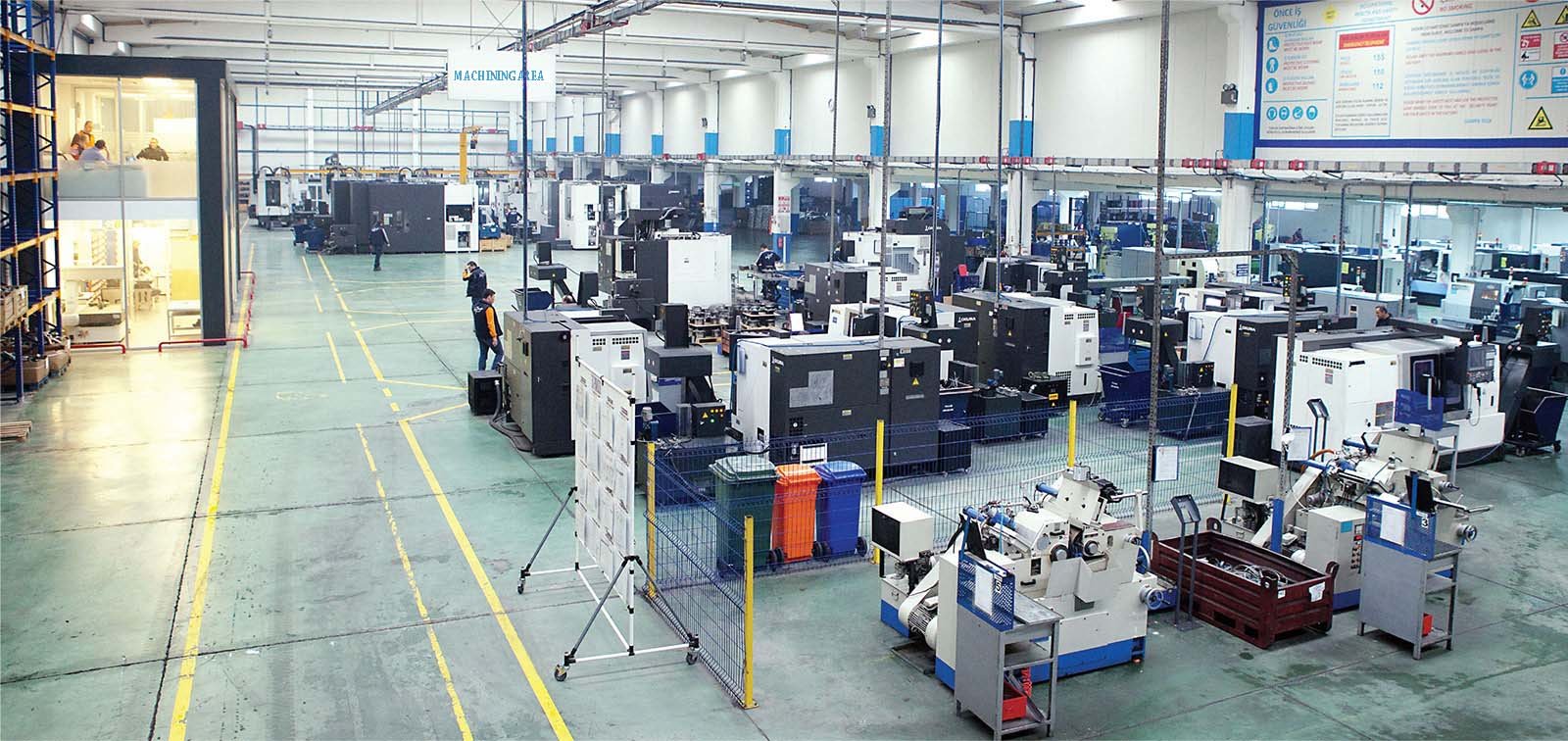Gears are fundamental components in a wide array of mechanical systems, serving as the backbone for transferring and modifying motion and force in countless machines. From the intricate inner workings of a wristwatch to the powerful transmission systems in automobiles, gears are indispensable in our daily lives.
Understanding gears—how they function, their various types, and their practical applications—provides valuable insight into the mechanics that power modern technology.
In this comprehensive guide, MaTec Vietnam will help you delve into the essentials of gears, exploring their design, operation, and significance in various industries, ensuring you have all the knowledge you need about these pivotal mechanical elements.
What is Gear and Importance of Gear?
What is Gear?
A gear is a rotating machine element with cut teeth or cogs that mesh with another toothed part to transmit torque. Gears alter the speed, torque, and direction of a power source. They are fundamental in mechanical devices, enabling complex motion and force transfer with precision.
Gears are found in numerous applications, from clocks and bicycles to car transmissions and industrial machinery, making them crucial components in the engineering and mechanics fields.
Importance of Gear
Power Transmission
Gears are fundamental to power transmission in mechanical systems. They enable the transfer of rotational force between different parts. The meshing of gears ensures efficient torque transmission, delivering the desired output effectively.
Speed Reduction and Amplification
Gears allow for the modification of rotational speed, which is vital in many applications. By adjusting the number of teeth on the gears, systems can either reduce or increase the input speed to match the required output speed. This flexibility is essential for tailoring the speed of operation.
Torque Multiplication
One of the most significant advantages of gears is their ability to multiply torque. By using gears of varying sizes, it is possible to increase or decrease the input torque. This capability is especially beneficial in applications like heavy machinery or vehicles, which require substantial torque.
Directional Changes
Gears are often employed to change the direction of motion in mechanical systems. Specific arrangements, such as bevel or worm gears, can redirect rotational motion at different angles. This functionality enables the creation of complex systems that can transmit motion in multiple directions.
Synchronization of Components
Many machines and devices rely on gears to synchronize the movement of different components. Multiple gears working together ensure that various parts move in unison. This synchronization is crucial for achieving smooth, coordinated operations.
In summary, gears are indispensable in mechanical systems for their roles in power transmission, speed adjustment, torque multiplication, directional changes, and synchronization of components.
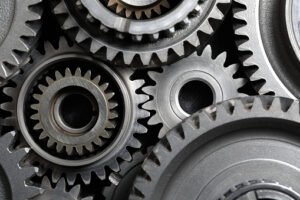
Types of Gears and Their Applications
There exists a variety of gear types, each possessing distinct characteristics and suitable applications. Below are the four primary types of gears that are essential to understand:
Spur Gears
Spur gears are the simplest and most common type of gear, featuring cylindrical teeth aligned parallel to the gear’s axis. They offer efficient power transmission and are cost-effective to produce due to their straightforward design. Spur gears are typically employed in applications where noise is not a concern, such as electric drills, conveyor systems, and washing machines.
Helical Gears
Helical gears have angled teeth arranged in a helix pattern around the gear’s circumference. When opposed to spur gears, its helical shape allows for quieter and more seamless operation. The gradual engagement of teeth reduces impact forces and enhances load-bearing capacity. Helical gears find widespread use in industries such as automotive transmissions, industrial machinery, and power generation.
Bevel Gears
The purpose of bevel gears is to transfer motion and power between shafts that intersect. They feature conical-shaped teeth and come in two main types: straight bevel gears and spiral bevel gears. Straight bevel gears, with straight teeth, are suitable for low-speed applications. In contrast, spiral bevel gears, with curved teeth, excel in high-speed and heavy-duty applications such as automotive differentials, marine propeller drives, and locomotives.
Worm Gears
Worm gears consist of a worm (a threaded shaft) and a gear (commonly known as a worm wheel). The worm teeth mesh with the gear teeth, enabling significant gear reductions and high torque transmission. Worm gears are renowned for their self-locking properties, preventing back-driving by the worm. They are ideal for applications requiring holding power or preventing reverse motion, such as lift mechanisms, conveyor systems, and steering wheels.
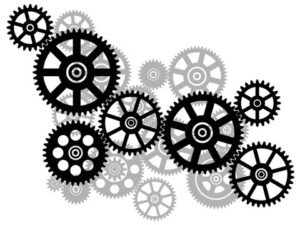
Five Gear Design Categories
Gears come in various styles and designs, each tailored to specific applications. Here are five key gear categories explored:
External Gears
External gears, also known as spur gears, are the most common and widely used type. They feature cylindrical gears with teeth positioned on the outer circumference. These gears have teeth parallel to the gear axis and engage with the teeth of other external gears to transmit power efficiently.
External gears are valued for their simplicity, cost-effectiveness, and reliability, making them ideal for applications such as automotive transmissions, industrial machinery, consumer appliances, and power tools.
Internal Gears
Internal gears have teeth around their inner circumference and mesh with an external gear of larger diameter. They offer advantages including compactness, torque transmission, and load distribution.
Compared to external gears, internal gears can handle higher loads and provide smoother operation due to their larger number of engaged teeth. They are commonly used in applications with limited space, such as planetary gear systems, gear pumps, certain gear reducers, and automotive parts.
Rack and Pinion Gears
Rack and pinion gears combine a linear gear (rack) with a cylindrical gear (pinion). The rack features straight teeth, while the pinion meshes with the rack to convert rotational motion into linear motion. Widely used in applications requiring precise linear movement, such as steering systems, machine tools, linear actuators, and various industrial machinery.
Planetary Gears
Planetary gears, also known as epicyclic gears, are highly flexible and efficient gear systems. They consist of a central gear called the sun gear, multiple planet gears that mesh with the sun gear, and an outer ring gear or annulus.
Planetary gears offer advantages such as high power density, compactness, and the ability to achieve multiple gear ratios. They find wide application in automotive transmissions, robotics, aerospace, and industrial machinery.
Non-circular Gears
Non-circular gears feature tooth profiles that differ from traditional circular gears. They are designed to accomplish specific motion patterns or control mechanisms. These gears are used in applications requiring precision motion control, speed variations, or intermittent motion, such as cam mechanisms, printing presses, rotary engines, and other mechanical systems that require custom motion profiles.
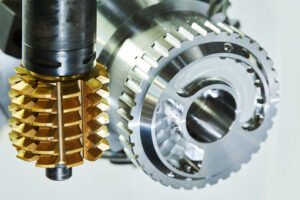
Considering When Selecting a Gear
Choosing the right gear for a specific application involves considering several key factors to ensure optimal performance. Here are some essential considerations:
- Load Capacity: The load capacity of a gear refers to its ability to transmit and withstand a certain amount of force. It’s crucial to assess the anticipated load and select gear that can handle it to avoid premature wear or failure.
- Speed Requirements: Speed is a critical factor in gear selection. Different gear types have varying speed capabilities, so choosing one suitable for the desired speed range is essential. Exceeding recommended speed limits can lead to increased wear and inefficiency.
- Space Constraints: The available space within the machinery or system must be considered. Gears come in various sizes and configurations, so selecting one that fits without compromising functionality is important.
- Operating Conditions: Factors such as temperature, lubrication, environmental conditions, and duty cycles can impact gear performance and longevity. Choosing gear suited to the operating conditions ensures reliable performance.
- Application Requirements: Each application has specific needs such as precision, gear ratios, backlash tolerance, and environmental compatibility. These requirements guide the selection process to meet desired performance criteria.
- Noise Requirements: For applications requiring noise reduction, selecting gears with features that minimize noise generation is crucial. Gears like helical gears offer smoother engagement and quieter operation compared to spur gears, for example.
- Cost Considerations: Cost is another significant factor in gear selection. Gear types differ in terms of manufacturing complexity, materials, and related prices. Balancing cost and function ensures an optimal choice.
>>> Read more: What is CNC Turning? Advantages of CNC Turning
The Role of Gears in CNC Machining
Gears play several critical roles in CNC (Computer Numerical Control) machining, facilitating various functions essential for efficient operation.
Power Transmission
Gears are instrumental in transmitting power from the motor to moving components within CNC machines, including the spindle, tool changer, and axis drives. This efficient power transfer enables the machine to execute accurate and controlled movements. CNC machines typically feature motors, drive systems, and gear mechanisms for power transmission.
Motors generate rotational power, which gears transmit to driven components. Spur gears, helical gears, or gearboxes are commonly used in different machine components to achieve the desired speed and torque. These gears provide low power loss during transmission thanks to their exact design and tooth engagement.
Speed Reduction
Different machining operations require varying rotational speeds on CNC machines. By changing the gear ratio between the motor and the driven components, gears, especially gearboxes, can reduce speed effectively. This enables the machine to achieve the correct cutting speeds and feeds for optimal machining.
In order to retain smooth surfaces and save machining time, higher rotational speeds with lower torque are preferable for high-speed machining or fine finishing. Gears with different tooth profiles, such as spur or helical gears, create gear ratios and reduce speed accordingly.
Motion Control
Gears, along with precision mechanisms like lead screws and linear guides, play a crucial role in motion control. They enable machines to move precisely, perform accurate positioning, rapid tool changes, and complex machining tasks by converting rotational motion into linear motion. As the motor rotates, gears and lead screws or ball screws convert it into linear motion, driving the machine’s axes.
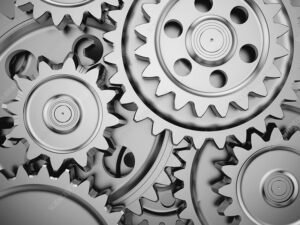
Conclusion
Overall, Gears are integral components in countless mechanical systems, offering precise power transmission, speed modulation, torque multiplication, directional changes, and motion synchronization. From the common spur gears to the complex planetary gears, each type serves specific purposes tailored to various applications.
Understanding the characteristics, functions, and considerations of different gears is crucial for selecting the right gear for a given task. Whether in CNC machining, automotive transmissions, industrial machinery, or consumer appliances, gears play a fundamental role in ensuring efficient and reliable operation.


